Karnataka 2023-24 Report
Click here to download the above report
Karnataka’s Dry Chilli Journey Since 1947
1950’s
Haveri District came into the limelight for Dry Chilli farming, especially the renowned “Byadgi” variant, which originated from Byadgi village known for its high-quality produce.
1960’s
Major cities like Mumbai, Ahmedabad, Delhi, Indore, etc., had big trade (sale) markets, enabling almost all spice and masala powder mill owners to purchase produce from these markets.
1970’s
Farmers from Hubli and surrounding areas started cultivating chillies, and Annigeri and Kundagol witnessed significant growth.
1980’s
The major problem of chilli crop “over-yield” was eliminated due to the rise in “Oleoresin Extraction.” This trend helped eliminate farmer’s over-yield woes.
1990’s
In this decade, Bellary and Raichur, with irrigated and fertile lands, started cultivating Dry Chilli.
2000’s
With the advent of “Cold Storage” units, farmers were able to store their dry chilli yield in such facilities. This, in turn, enabled dry chilli to retain its quality for an extended period. Now, the present storing capacity stands at 70+ Lakh bags.
2010’s
Digitisation: Karnataka state implemented a digital tender system at all of its APMC mandis. This large-scale digital move helped bring transparency and gained the trust of farmers.
2020’s
Karnataka still leads the Premium Dry Chilli Industry category, aided mainly by its Byadgi / KDL variety.
Dry Chilli is considered a major cash crop in India. It is primarily grown in states like Karnataka, Andhra Pradesh, and Telangana. Karnataka is one of the major markets for farmers who cultivate dry chilli. The state alone holds a lion’s share of 25% in the whole of India. The major chilli growing belts, like Hubli, Bellary, and Raichur, are present in Karnataka.
HUBLI is known for growing a popular Byadgi / KDL variety aptly named “Local”. This variety is significant and boasts the highest colour value (up to 270 ASTA) among chillies. It has a high shelf life due to being grown organically in the traditional manner. The central chilli growing areas are Kundagol and Annigeri.
BELLARY is also one of the most extensive chilli-growing areas in Karnataka. The main chilli varieties grown here are Byadgi / KDL, Dabbi, Syngenta 5531, and Syngenta 2043.
RAICHUR also has the best environment and areas suitable for cultivating varieties like Byadgi / KDL, Super – 10, Indo – 5, Syngenta 5531, and Syngenta 2043.
| Area | Sowing period | Harvest period |
| Hubli | June – July | November – March |
| Bellary | July – August | January – April |
| Raichur | July – September | February – May |
Major top qualities at Karnataka
- Byadgi / KDL : Colour – 270 ASTA and Heat – 10000 SHU
- Dabbi / Kashmiri : Colour – 270 ASTA and Heat – 8000 SHU
- Syngenta 5531 : Colour – 150 ASTA and Heat – 45000 SHU
- Devanur Deluxe : Colour – 160 ASTA and Heat – 30000 SHU
Crop Report
Sowed Area – Due to the price surge in previous years, the farmers increased the sowing area by 30% – 35%.
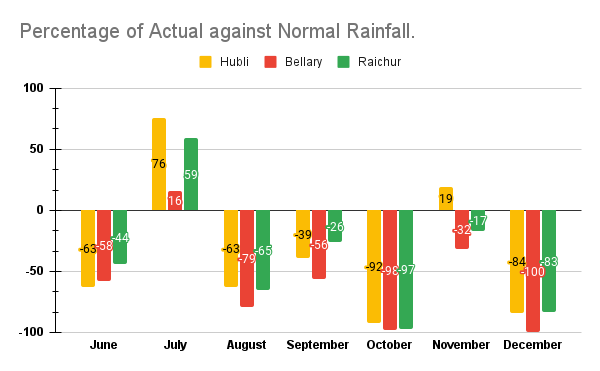
Karnataka Reservoir in 2023-24.
Date of water released
| Year | 2020-21 | 2021-22 | 2022-23 | 2023-24 |
| Tungabhadra | 1st August | 25th July | 13th July | 1st August |
| Almatti | 23rd July | 24th June | 12th July | 26th July |
Total water released from June to December 15th in cusecs
| Year | 2020-21 | 2021-22 | 2022-23 | 2023-24 |
| Tungabhadra | 24 lakhs | 31 lakhs | 60 lakhs | 12 lakhs |
| Almatti | 59 lakhs | 69 lakhs | 68 lakhs | 22 lakhs |
Total water storage available on December 15th
| Year | 2020-21 | 2021-22 | 2022-23 | 2023-24 |
| Tungabhadra | 79% | 96% | 88% | 12% |
| Almatti | 96% | 86% | 98% | 59% |
Dry Chilli Market Report for Karnataka: 2023 – 24
In this report, we will interpret data about the arrivals of 2023 – 2024, as well as prices and valuable insights. Given below are monthly reports starting from December 2023:
- December 2023
- January 2024
- February 2024
- March 2024
- April 2024
- May 2024
December – 2023
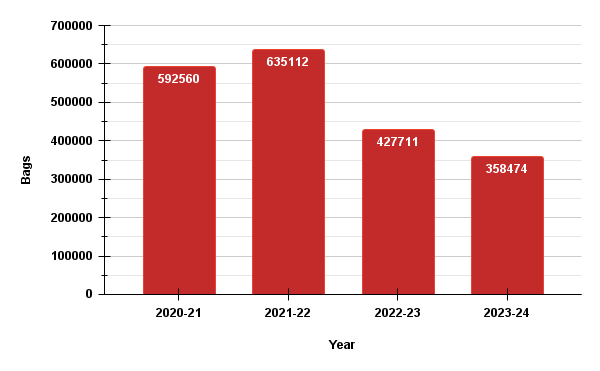
- The major on-time produce arrivals were of the Syngenta 5531, Syngenta 2043, and Sarpan102 varieties. Byadgi / KDL produce got delayed by one month, and the produce started arriving from the 1st week of January 2024.
- The comparisons with last year indicated that the sowing was delayed by 20 days, and also, the arrivals were 20% less at 3.58 lakh bags.
- Prices of Byadgi / KDL, as noted in the last week of December 2023, were Rs 48,000 and Syngenta 5531 at Rs 16,000. This showed that the price saw a decrease of 20% – 25% from the 1st week of December to the last week of December.
- The persistent cold weather in the month of December 2023 proved beneficial to the chilli crops. This led to the good performance of chilli crops that were grown in Hubli, Bellary, and Raichur, especially the traditional Byadgi / KDL crops grown in Hubli after a gap of 3 years was looking good.
- The year 2023 saw Karnataka take a huge carry forward stock of 25-30 Lakh bags to the cold storages against the capacity of 70 Lakh bags.
- With no unseasonal rains, this ensured good quality of chilli crops.
- Reservoir Status: Compared with the last four years, the water level was low but sufficient for first picking. For future good picking, rainfall and cold weather are necessary. In simpler terms, it was 60% – 70% less, and the outflow was also noted to be 60% less.
January- 2024

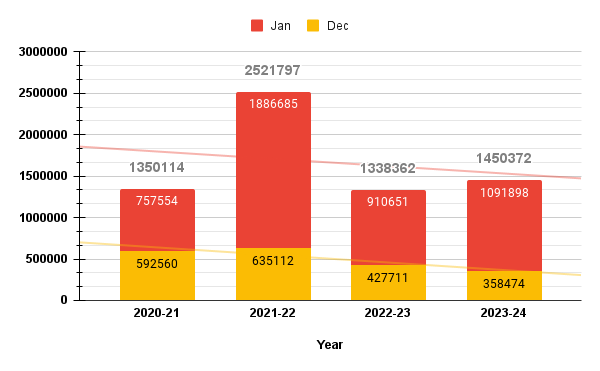
- The significant arrivals in this month were varieties like Syngenta 5531, Syngenta 2043, and Byadgi / KDL.
- The sowing was delayed by one month when compared with January 2023, so there were high chances of increased February arrivals.
- When compared with January 2023, the percentage of arrivals with respect to colour medium and top quality was higher.
- In the last week of January 2024, the Byadgi / KDL price was Rs 43,000, and Syngenta 5531 was Rs 14,000. However, this month saw a price decrease of 10% – 15%.
- The weather in January 2024 was perfect for crops. Hence, crops from Bellary and Raichur performed really well. This perfect climate ensured that the produce would have a higher yield and high quality.
February – 2024


- The major arrivals this month were Syngenta 5531, Byadgi / KDL, Syngenta 2043, and Dabbi chilli varieties.
- The prices in the last week of February 2024 were recorded to be Rs 38,000 for Byadgi / KDL and Rs 15,000 for Syngenta 5531 varieties.
- The Byadgi / KDL arrivals came at a higher scale than the previous year. However, the top-quality arrivals were lower than those of the second-quality arrivals.
- Dabbi chilli variety started arriving from the 3rd week with improved quality. It was noted that the arrivals of this variety will increase from the 1st week of March 2024.
- The weather in February 2024 was good for crops. However, due to soaring high temperatures, the quality was affected.
- There were single or fewer pickings in some areas.
March – 2024
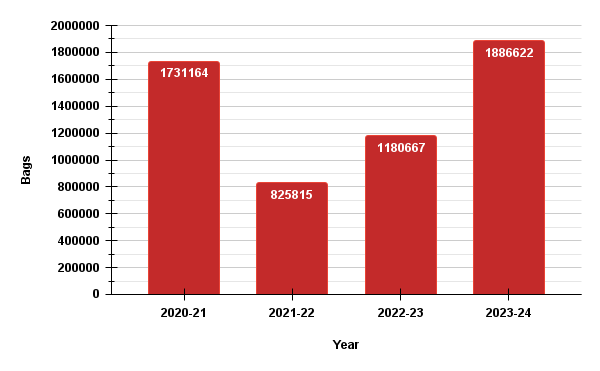
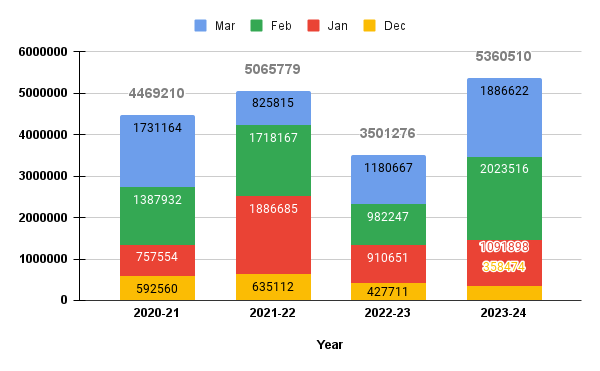
- The significant arrivals that came in March 2024 were Byadgi / KDL, Dabbi, Syngenta 5531, Indo-5, and Syngenta 2043.
- Still a lot of farmer produce was at farm’s, but cold storages were nearing full capacity.
- Hubli area’s organic Byadgi / KDL variety started arriving in large quantities, and it would continue till the end of April 2024.
- There was low rainfall during the 5th week of March during the Holi festival, but it had no adverse impact on the crops.
- The Dry Chilli Bubble Burst – From the last 4 years farmer’s were getting good returns hence area was increased drastically, with no damage due to weather this year, yield had come out good. Coming year’s area may decrease.
April – 2024
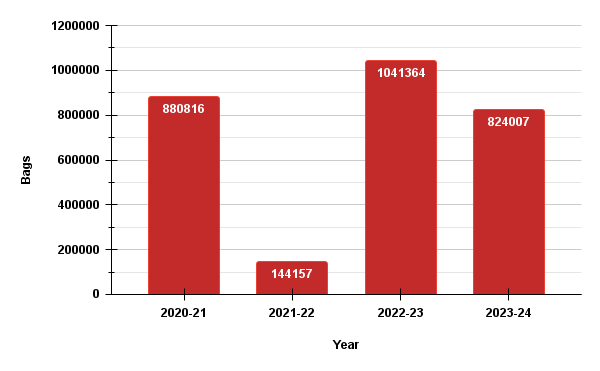
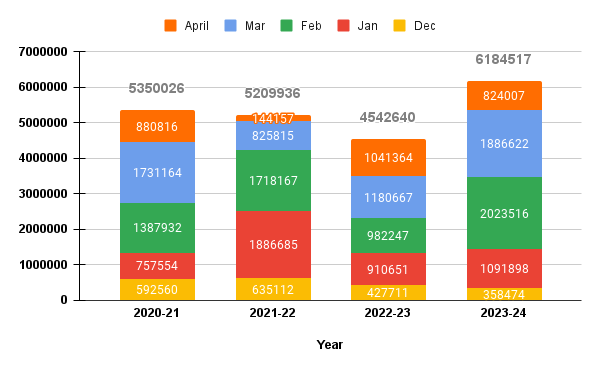
- In April 2024, the arrivals were 20% less than in April 2023.
- On a combined calculation from December 2023 to April 2024, it was noticed that there was a 35% increase in arrivals when compared with last year’s findings.
- The temperature soared rapidly, which affected the colour values of the chillies.
- Karnataka’s cold storages, which have a capacity of 80+ Lakh bags, were completely occupied.
- Karnataka’s crop arrivals crossed 60 Lakh bags this year, and this shattered all the previous records of the past five years.
May – 2024

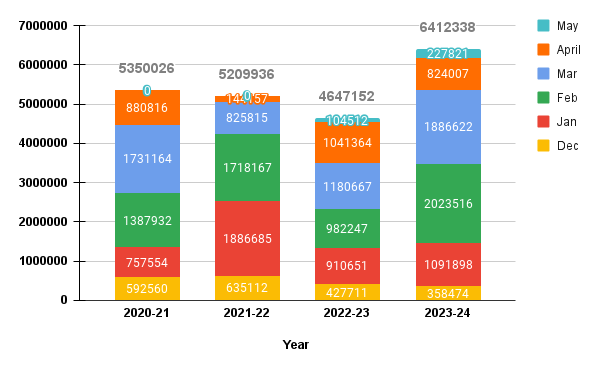
- The arrivals in this month were 120% more than last year’s arrivals.
- The cumulative arrivals increased at the rate of 38% from December 2023 to May 2024.
- The total arrivals for the year 2023-2024 stood at 64 Lakh bags. This number is 38% higher than last year and 20% higher than the previous set record. This indicates that 2023 – 2024 arrivals have shattered all the past records and set new ones.
The year 2023-24 Summarised
- Around 64 lakh bags hit the market this year from december 2023 to may 2024, which is 38% increase than last year.
- Karnataka has about 70+ lakh bags of cold storage capacity, by may 2024 they were 100% capacity occupied(this includes 20% of previous year’s stock).
- Unlike previous 4 years, this year KDL / Byadgi was sowed by farmer’s on large areas which includes Anantapur and also traditional Hubli area farmer’s got good yield this year due to lower rainfall.
- This year fatki(low quality) was very negligible as there was no unseasonal rainfall.
- Chilli was arriving at market till July 2024, last year arrivals were till may 2023.
Opportunity for IPM Byadgi Chilli
The Hubli area, comprising the Annigeri and Kundagol areas, is widely known for growing Byadgi chilli in the traditional organic way on rain-feed. Though it yields less, the qualitative aspect of the chilli from this region always sells at a premium price.
This year, due to the overflow of arrivals from irrigated areas, the price was affected, and it started being traded at low prices, making the farmers’ economic viability unsustainable. This trend pushed the farmers to opt for stocking it in cold storages. There is a good quantity of IPM chillies stock available at cold storages, which are best suited for companies targeting European and US markets.
About SpiceExtra.in
Shri. Nagappa ji Hampali founded “Hampali Traders” in 1968, a respectable trading firm dedicated to Byadgi Dry Chilli in Hubli, Karnataka. By late 2017, when businesses were digitally transforming, we noticed that no digital information related to dry chillies. This troubling factor led us to work towards digitising this area from scratch.
Associating and partnering in R&D with renowned personalities from Agronomy, Software Engineering, Weather Experts, Government Agencies, Media Houses, and others paved the way for incubating the “SpiceExtra” platform.
SpiceExtra is a platform for Research and Development(R&D) initiatives on Dry Chilli with a significant focus on Digitising – Price and Arrivals, Crop survey, Assaying, and Branding.
Connect us at www.SpiceExtra.in and BasuHampali@gmail.com
Five Years Of Magazine Making!
Byadgi Dry Chilli is grown in Karnataka. It is known for its rich colour, flavour, aroma, and low pungency.
It’s widely used in Pickles, Curry Powders, Food Colouring, and the Pharmaceutical Industry. Even though it has a high significance, we felt sad when we witnessed that there was not much branding or promotional activity related to this dry chilli variety until 2019. So we decided to start coming up with magazines both in digital and hardcover formats since then, and 2024 marks our fifth year of publication.
We at SpiceExtra intend to bring a series of 3 magazines in the next 3 years talking about the importance of Byadgi chilli and promoting its use cases. The magazine themes revolving around our hero crop, “Byadgi Dry Chilli”, are as follows:
- Series – 1 : Pickles
- Series – 2 : Curry Powders
- Series – 3 : Food Colouring & Pharmaceutical
ನಮ್ಮ ಬ್ಯಾಡಗಿ, ನಮ್ಮ ಹೆಮ್ಮೆ!
हमारी ब्याडगी, हमारी शान!
Our Byadgi, Our Pride!